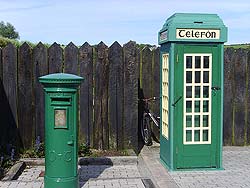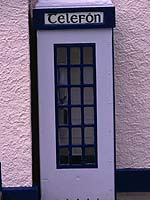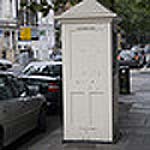| |

Traditions, folklore, history and more. If it's Irish, it's here. Or will be!
"People will not look forward to posterity who never look backward to their ancestors."
-Edmund Burke




Quotes
Library: Books, Movies, Music
Prints & Photos
Poetry
Jokes


Shops Ireland
Bunús na Gaeilge
(Basic Irish)
Circle of Prayer
Blessings
Did You Know?
Himself/Herself
Write to Us
Readers Write..
Links/Link to Us
Advertise with us
Awards & Testimonials
Submissions Guide


|
|
|
 Last call for Ireland's phone boxes? Last call for Ireland's phone boxes?
by Mattie Lennon
The day of the familiar Irish phone box is drawing to a close. Earlier this year the powers-that-be decided to reduce the number of post boxes from 4,850 to 2,699. Since usage of the public phone has fallen by 80% in the past five years, how long before the total demise of the phone box?
The Kiosk, especially in rural areas, provided a valuable link with the outside world. But, in the words of Clinical Psychologist, Marie Murray, “ What of their psychological significance rather than their utilitarian worth? What role did they play in the lives of people? What privacy did they afford, away from the home telephone for those lucky enough to have a telephone in the house but unfortunate enough to have no privacy using that instrument at home?” Dr. Murray goes on to say that phone boxes , “will become but quaint memories of an older generation regaling their grandchildren with tales of trysts at the local telephone box or romance conducted through whispered confidences in that semi-private box in the middle of the village or at the end of the road . . . ”
 In the days when one went through the Operator there was the story of the Cavan man who phoned his friend looking for the loan of a tenner only to be told, “It’s a bad auld line, I can’t hear you.” When the request was repeated it was, once again, met with, “I can’t hear you”. At this stage the Operator cut in with, “I can hear him perfectly”. The answer was ready, “You give him the loan of the tenner, so.” In the days when one went through the Operator there was the story of the Cavan man who phoned his friend looking for the loan of a tenner only to be told, “It’s a bad auld line, I can’t hear you.” When the request was repeated it was, once again, met with, “I can’t hear you”. At this stage the Operator cut in with, “I can hear him perfectly”. The answer was ready, “You give him the loan of the tenner, so.”
The first “public” phone in our area was in the Post Office in Lacken where most of the calls were to the Priest, the Guards, the Doctor, the Vet or The A.I. man (or “the collar-and-tie-bull” as he was known.) The Post Office was also a shop which opened late so nocturnal communications pertaining to illicit relationships could sometimes be conducted, albeit in whispered tones. (Or so I’m told.)
Lacken eventually got a Phone-Box and conversations could be carried out in a stentorian voice without fear of “ear-wigging.” Some “coins” used were not Legal Tender (or even legal.) Washers of a certain diameter and “push-outs” from galvanised junction-boxes used by electricians would suffice. (Or so I’m told.)
 By “tapping out” the numbers on the top of the cradle (1,9 and 0 were free) one could get through to any number. (Or so I’m told.) When Decimal-Currency was introduced in 1971 it took a while to have the Phones adapted. The new Decimal 1P coin was exactly the same size as the old sixpence and worked very well. (Or so I’m told.) By “tapping out” the numbers on the top of the cradle (1,9 and 0 were free) one could get through to any number. (Or so I’m told.) When Decimal-Currency was introduced in 1971 it took a while to have the Phones adapted. The new Decimal 1P coin was exactly the same size as the old sixpence and worked very well. (Or so I’m told.)
Another favourite trick was to block the return-chute with a piece of rolled up twine and to return for the proceeds when a number of people had pressed “Button B” without getting any refund. (Or so I’m told.)
Nowadays when I hear the Dublin joke, “What do Northside girls use for protection? A Phone-box”, it reminds me that at times in rural Ireland the Phone-box was often utilised for erotic pelvic activity while parallel with the perpendicular. (Or so I’m told.) When a not-too-well-liked person would be retiring it would be said, “They’re holding his retirement do in a phone-box”.
When the story broke, that the phone box was about to be consigned to history, True Films, a Dublin based company, decided to make a film about its passing. They put an letter in Ireland’s Own asking for “phone box stories” and it took off from there.

The first phone box in Ireland (1925) in Dawson Street, Dublin. It's still there.
Director Ross Whitaker told me, “My colleague Aideen O ‘Sullivan and I were working for a television company together and Aideen starting telling me about how she'd read in the paper that many of the phone boxes around the country were to be removed. It sparked a discussion among us and our workmates where we all recounted stories that we'd heard about phone boxes. There seemed to be so much to say about them. A few days later I saw that the Irish Film Board had a call out for ideas for short documentaries. I got on the phone to Aideen and we decided to draw up a proposal. The Film Board liked it and eventually, after presenting the idea to them at a meeting, we were commissioned to make it.”
 The crew travelled the length and breath of the country interviewing people and were well pleased with the result. Ross says, “I love the stories that we heard while making the film. The funniest is told by a man from Donegal about two ladies who get stuck in the phone box, although the humour comes as much from the way he tells it.” He is anxious to point out that theirs is not a campaign, “It's not our aim to start some kind of revolutionary movement to counteract their removal. We just want to capture some of the memories that people have of them before they disappear completely.” The crew travelled the length and breath of the country interviewing people and were well pleased with the result. Ross says, “I love the stories that we heard while making the film. The funniest is told by a man from Donegal about two ladies who get stuck in the phone box, although the humour comes as much from the way he tells it.” He is anxious to point out that theirs is not a campaign, “It's not our aim to start some kind of revolutionary movement to counteract their removal. We just want to capture some of the memories that people have of them before they disappear completely.”
The film is called Bye Bye Now and the first screening will be in the Cork Film Festival in early November.
ED. NOTE: Bye Bye Now won the Audience Award for Best Irish Short Film.
Photo Credit: The Cork Film Festival
 To read more from and about Mattie Lennon please click Tribute to Eamon Kelly. You'll find Matties bio at the end. To read more from and about Mattie Lennon please click Tribute to Eamon Kelly. You'll find Matties bio at the end.
To read more of his stories visit his website at Mattie Lennon.
|
|
Fri, Sep 27, 2024
 The Galway Hooker The Galway Hooker
This unique vessel, with its distinctive curved lines and bright red sails, originated in the village of Claddagh. During the 19th century, hookers supported a significant fishing industry and also carried goods, livestock and fuel. Seán Rainey is remembered for building the last of the original boats, the Truelight, for Martin Oliver who was to become the last king of the Claddagh; as king, he was entitled to white sails on his boat. Since the mid seventies, many of the old sailing craft which were on the verge of extinction have been lovingly restored and new ones have been built. During the summer months they can be seen at festivals such a Cruinniú na mBád - the Gathering of the Boats - in Kinvara.
Click for More Culture Corner.
|
|




 The Galway Hooker
The Galway Hooker